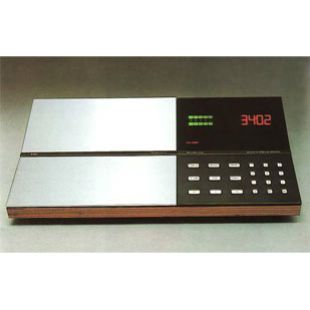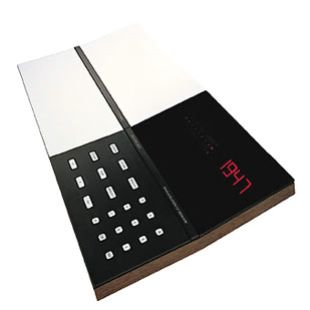BeoCord 8000 Cassette Deck
Manufactured: 1980 - 1981
Designer: Jacob Jensen
Colours: Teak, Rosewood, Oak, White
When you used metal tape cassettes in the Beocord 8000 you obtained the same high quality sound you were used to from a good gramophone record. Careful choice of components and materials, creative engineering and technical excellence all made this possible.
But superb sound reproduction was only one of the benefits you got from this advanced cassette deck, which replaced Beocord 5000. Of equal importance was the fact that time, through Beocord 8000, came to the cassette deck. Bang & Olufsen used it to measure tape consumption. Quite simply, instead of using meaningless digits, minutes and seconds were used instead. This allowed you to locate specific tracks of music easily and accurately for immediate replay. Just tell the Beocord 8000 where to start, in minutes and seconds and let the set's microcomputer do the rest.
This feature also helped you plan recordings and thereby ensure maximum use of your tapes. During play, Beocord 8000 measured and displayed the exact amount of tape consumed so that you always knew how much playing time was left on the cassette. And the Beocord wouldn't let you make mistakes: if you gave incorrect instructions, reject signals flashed on the set's display panel. The microprocessor which made the real time counter possible was also used to provide a digital clock for timer recording. In normal use the clock did not show on the display, but it could be programmed to start the tape either playing back or recording any time within 24 hours.
The button marked 'RETURN' afforded great convenience during recording. Together with the automatic tape position indicator, it enabled you to edit your tapes electronically. The split-channel Peak Programme Meter eased the setting of recording levels and was extremely accurate. It indicated the actual signal that was being fed to the tape, for each channel, rather than that which was being received at input.
Underneath the brushed aluminium panel was the cassette compartment, sliders for setting recording level, an independent slider for adjusting volume level on headphones, facilities for timer programming and adjustments for secondary functions.
For example, you could instruct Beocord 8000 to make recordings of radio programmes while you are out. In short, everything was done to ensure total listening pleasure in terms of sound reproduction and convenience.
Beocord 8000 could be used as a stand-alone tape cassette recorder or as part of hi-fi systems such as Beosystem 6000 or Beosystem 8000.
____________________________________________________________________________________________________________
***** Do you have one of these you're looking to sell? Try our site sponsor www.beobuyer.co.uk for a quote! *****
____________________________________________________________________________________________________________
BeoCord 8000 Cassette Deck Product Specifications
Types:
4824 (1980 - July 1982)
127V 4823 (1980 - April 1980)
AUS 4826 (1980 - Nov 1980)
GB 4825 (1980 - Aug 1981)
J 4827 (1980 - June 1981)
USA 4822 (1980 - Aug 1981)
Compact cassette: C46-C60-C90-C120
Tape head: Sendust
Noise reduction: Dolby NR
Tape switch: Auto. ferro/chrome, man. metal
Wow and flutter DIN: <+/- 0.1%
Speed deviation: <+/-1%
Fast forward and rewind: C60 70 sec.
Frequency range chrome/metal/ferro
30 - 16,000 Hz +/- 3 dB (with MPX filter)
Signal-to-noise ratio metal Dolby: >68 dB
Signal-to-noise ratio chrome: Dolby >65 dB
Signal-to-noise ratio ferro: Dolby >63 dB
Power consumption: Max. 45 W
Dimensions W x H x D: 53 x 13 x 30cm
Weight: 7.5 kg
Connections: microphone input: 0.1 mV/2.2 kohms
AUX input: 120mV/1.2 kohms
Headphones: max. 9 V/56 ohms
Related Products
- BeoGram 8000 Record Deck
- BeoMaster 6000 Tuner/Amplifier Types 225x
- BeoMaster 8000 Tuner/Amplifier
- BeoCord 8002 Cassette Deck
- BeoCord 8004 Cassette Deck
- BeoCord 9000 Cassette Deck
- BeoCord 6002 Cassette Deck
- BeoCord 6000 Cassette Deck
Related Articles
Created: 15th December 2006
Modified: 3rd March 2019
Author Notes:






